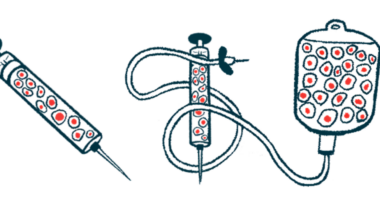AAN 2025: Gains from CNM-Au8 in RRMS linked to nerve cell repair
New data show evidence of remyelination with therapy's use, per developer

Clinical improvements in vision and cognition linked to the use of treatment candidate CNM-Au8 were correlated with signs of nerve cell repair and remyelination among people with relapsing-remitting multiple sclerosis (RRMS), according to new data.
Remyelination is the process by which myelin, the fatty substance surrounding nerve cells that’s lost in multiple sclerosis (MS), is restored; it’s the goal of CNM-Au8 treatment, which aims to protect neurons, or nerve cells, and aid in the generation of myelin.
The findings come from the Phase 2 VISIONARY-MS clinical trial (NCT03536559) and its long-term extension study VISIONMS-LTE (NCT04626921), both sponsored by Clene, the therapy’s developer.
The data were discussed in a late-breaking presentation, titled “Physiologic and Anatomical Evidence of Neuronal Repair and Remyelination from the Long-Term Open-Label Extension of the Phase 2 VISIONARY-MS Trial,” at the American Academy of Neurology (AAN) Annual Meeting, held April 5-9 in San Diego and online.
“These results underscore the fact that CNM-Au8 treatment in the Phase 2 VISIONARY-MS trial not only led to clinical improvements, but also demonstrates that these observed clinical benefits resulted from underlying tissue repair and evidence of remyelination,” Ben Greenberg, MD, head of medical for Clene, said in a company press release detailing the findings.
“We look forward to confirming these data in a global Phase 3 trial,” Greenberg added.
VISIONARY-MS and VISIONMS-LTE tested CNM-Au8 in RRMS patients
MS is characterized by misguided immune attacks that damage myelin. There are mechanisms in place to repair or replace damaged myelin, but these remyelination processes are also impaired in people with MS.
CNM-Au8 is an oral liquid suspension of gold nanocrystals intended to improve cellular metabolism and boost energy production in nerve cells, helping to safeguard them against damage. It’s also thought to promote the production of new myelin by oligodendrocytes, the myelin-producing cells of the brain and spinal cord. Altogether, this is expected to contribute to repair processes that slow MS progression.
VISIONARY-MS enrolled 73 people with RRMS — in which disease relapses are interspersed with periods of remission — and stable disease. Eligible participants hadn’t had a relapse or new MRI activity in the prior six months. All had vision problems resulting from chronic optic neuropathy, or damage to the optic nerve that sends signals between the eyes and the brain.
The participants were randomly assigned to receive one of two doses of CNM-Au8 — 15 mg or 30 mg — or a placebo, once daily for about a year. Most were also being treated with background MS therapies.
Treatment with CNM-Au8 led to significant improvements in a vision test called low contrast letter acuity, or LCLA. This test assesses a person’s ability to read lines of increasingly smaller letters — much like a standard eye chart — but the letters are of lower contrast, such as faint gray, so they don’t easily stand out from the background. LCLA is known to correlate with vision-specific life quality and overall disability in people with MS, according to Clene.
Use of the therapy also led to improvements in neurological function, with evidence of improved brain health after a year.
After completing the main study, 55 participants entered into VISIONMS-LTE, where all received CNM-Au8 (30 mg) for about two years — a total of nearly three years of treatment for those who received CNM-Au8 in VISIONARY-MS.
Improvements correlated with biomarkers seen in nearly all patients
The newly presented data, consistent with previous reports, showed that CNM-Au8 continued to be associated with clinical improvements and indicators of improved nerve health in the extension study.
In particular, improvements were observed in the latency and amplitude of visual evoked potentials, known as VEPs. These measures are indicators of the speed and strength of electrical signals being sent from the eyes to the brain, with an improvement reflecting possible optic nerve repair.
MRI data also indicated improvements in the brain’s neuronal structure suggestive of remyelination.
For those who had been on CNM-Au8 since the start of VISIONARY-MS, continued improvements in LCLA were observed with up to nearly three years of treatment, in addition to improvements in cognitive processing speed, as assessed by the symbol digit modalities test (SDMT).
These types of clinical improvements have not been observed with other MS treatment candidates designed to drive nerve cell repair, according to Clene.
“For years there have been attempts to test potential remyelination therapies in MS with little to no success,” Greenberg said. “Even for interventions that yielded nominal changes in MRI or physiology measures, there was a lack of consistent, robust clinical benefits to participants.”
These analyses confirm the improvement of structure and function in the brains of MS patients treated with CNM-Au8 during the long-term extension of [the] VISIONARY-MS [clinical trial].
Researchers now showed that LCLA and SDMT clinical improvements correlated with these other biomarkers of nervous system repair.
For example, 96% of people who had an LCLA response indicative of visual improvements also exhibited MRI improvements suggesting remyelination. Meanwhile, 91% of LCLA responders showed improvements in VEP.
Likewise, 98% of SDMT responders with improved cognition exhibited corresponding MRI improvements, and 91% of SDMT responders also had a VEP response.
According to the presentation, “nearly all participants with SDMT and LCLA improvement had concordant improvements on MRI … and VEP.”
Per the researchers, “these analyses confirm the improvement of structure and function in the brains of MS patients treated with CNM-Au8 during the long-term extension of VISIONARY-MS.”








